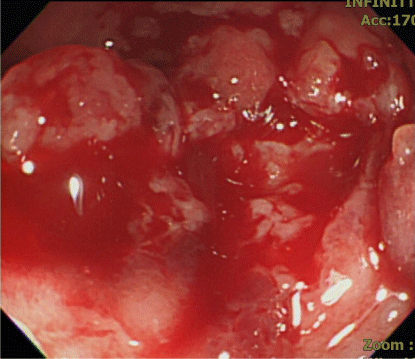
Clinical Image
Austin J Surg. 2018; 5(1): 1123.
Syphilitic Proctitis Mimicking Rectal Cancer
Chen HW, TaLee C and Chang KC*
Department of Pathology, National Cheng Kung University and Hospital, College of Medicine, National Cheng Kung University, Tainan, Taiwan
*Corresponding author: Kung-Chao Chang, Department of Pathology, National Cheng Kung University and Hospital, College of Medicine, National Cheng Kung University, Taiwan
Received: December 06, 2017; Accepted: January 12, 2018; Published: February 08, 2018
Clinical Image
A 27-year-old homosexual man presented with a 2-week history of intermittent anal bleeding after defecation. Sigmoidoscopy (Figure A) revealed a protruding mass (4x6 cm) with fragile mucosa at the rectum, 5 cm above anal verge.Biopsy was done.Histology (Figure B) reveals a diffuse chronic inflammatory cell infiltrate composed of many plasma cells in the colonic lamina propria and submucosa. The dense plasma cells raised the possibility of syphilis. Immunohistochemical staining (Figure C) shows diffuse positivity for spirochete. Consequently, the diagnosis was syphilitic proctitis. Then, he was receivedpenicillin G benzathine therapy.His boyfriend was diagnosed with primary syphilis in genital area later.

Figure 1: Sigmoidoscopy revealed a protruding mass with fragile mucosa at
the rectum, 5 cm above anal verge.

Figure 2: Histology showsa diffuse chronic inflammatory cell infiltrate
composed of many plasma cells (inset) in the colonic lamina propria and
submucosa.

Figure 3: Immunohistochemical staining shows diffuse positivity for
spirochete.
Proctitis is an inflammatory process of the lining of the distal colon and rectum [1]. Patients presenting with acute proctitis should receive anoscopy and be evaluated for infection with testing for HSV, N. gonorrhoeae, C. trachomatis, T. pallidum, and HIV [2]. Syphilitic proctitis is rarelyobserved because of its low incidence and the lack of specific signs and symptoms. It usually mimics a neoplasm [3]. Syphilis proctitis must be considered first in patients under immunosuppressive status or with history of men who have sex with men. The common symptoms of syphilitic proctitis are hematochezia, tenesmus, mucous discharge, and changes in bowel habit. The endoscopic appearance may vary from diffuse edema, erythematic, friable or multiple erosions, to ulceration [4]. Antibiotics are curative.
References
- Hoentjen F, Rubin DT. Infectious proctitis: when to suspect it is not inflammatory bowel disease. Dig Dis Sci. 2012; 57: 269-273.
- Sandgren KE, Price NB, Bishop WP, McCarthy PJ. Herpes simplex proctitis mimicking inflammatory bowel disease in a teenaged male. Case Rep Pediatr. 2017; 2017: 3547230.
- Song SH, Jang I, Kim BS, Kim ET, Woo SH, Park MJ, et al. A case of primary syphilis in the rectum. J Korean Med Sci. 2005; 20: 886-887.
- Bassi O, Cosa G, Colavolpe A, Argentieri R. Primary syphilisof the rectum-- endoscopic and clinical features. Report of a case. Dis Colon Rectum. 1991; 34: 1024-1026.